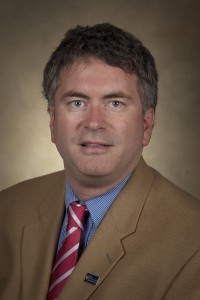
TUSCALOOSA, Ala. — Continuing efforts to introduce computer science to high school students, a $1 million grant was awarded to The University of Alabama to train teachers in a new computer-science course and future College Board AP exam.
The grant from the National Science Foundation to Dr. Jeff Gray, associate professor of computer science in the UA College of Engineering, builds upon his work with the College Board to craft a new Advanced Placement computer-science course designed to increase secondary and post-secondary educational interest in computer science and improve collegiate preparation for science, technology, engineering and mathematics, or STEM, majors.
“We’re trying to raise awareness of how software affects everything we do,” Gray said. “Software is everywhere, and computing will change all the other sciences and engineering.Technology is as important to learn now as physics was 100 years ago, yet computer science is not taught in the overwhelming majority of high schools.”
The three-year grant begins in January and will train 50 high school teachers across Alabama to lead a proposed Advanced Placement course in computer science that allows students the opportunity for college credit if they score well on the AP exam. Gray is instrumental in developing the course, CS Principles, through ongoing work with NSF and the College Board. This year, UA is one of two universities to further pilot the new AP course and has been a member of the NSF/College Board Pilot team since 2011.
The College Board requires universities offer college credit for corresponding courses to make the new course and exam successful. The College Board could begin the new AP computer science course in 2015 after the data from the pilot program is analyzed and the college-level course is polished.
During the grant, the University is partnering with A+ College Ready, which focuses on increasing access to rigorous college-level content throughout Alabama high schools, in recruiting and supporting teachers and students who will participate in the initiative.
The 50 Alabama teachers will be supported through year-round professional development with stipends, equipment purchases, assistance from UA students and summer workshops. Most teachers are certified to teach AP-level courses after week-long training sessions, but more intensive training is needed to teach computer science than subjects teachers studied in college and taught throughout their career, Gray said.
“With this training and support, they will be ready to teach that class in a way that prepares their students to be active and engaged learners through inquiry-based instruction,” Gray said.
The grant will also support weekend and summer camps for high school students that will enrich their understanding of computer science and prep for the exam. It’s estimated more than 1,300 Alabama high school students would be taught by the teachers over the course of the grant.
The new AP computer science course would not replace the existing AP computer science course, which focuses on specifics of computer programming, but delve deeper into computer science by exposing students to networking, algorithms, big data, computer logic and creativity needed to design software.
A particular focus will be instruction to program smartphone applications on the Android platform and how such applications affect many different segments of society. It’s expected the course will have broader appeal compared to the current AP course, Gray said.
“The whole thing is getting them started early to let them know the growing career options in computer science,” he said. “We also want them to teach something with more rigor so students get an accurate depiction of computer science.”
Gray said the traditional technology courses in most high schools that introduce Microsoft Office and other computer applications often give a misrepresentation of the true nature of computer science.
The first 10 teachers will come from a group who already teach computer science in state high schools or have attended previous summer computer science workshops at UA hosted by Gray through a grant from Google’s Education Group.
Those 10 teachers will implement the new course with support from UA in the first year of the grant. In the second and third year, the teachers will help train the next 40 teachers. The Alabama Department of Education will provide support through the ACCESS distance learning network to help with professional development during the grant.
A+ College Ready is working with the University for the pilot study of the proposed new AP computer science course. If the pilot is successful, A+ College Ready program schools throughout the state will offer the new computer science course, increasing access for Alabama students to rigorous and engaging coursework in STEM subjects.
Alabama students lag behind most other states in taking the current AP computer science course, although there has been improvement in recent years. There were 97 students who took the Computer Science AP exam in 2012, nearly double the participation in 2010. Still, Alabama has low participation when compared to Georgia, which had 1,037 students take the exam in 2012, according to Gray.
In Alabama, only three teachers are certified by the College Board to teach the current AP computer science course, and five other teachers across Alabama teach some aspect of computer science, Gray said. This low participation can be compared to other subjects such as United States history with more than 5,200 Alabama students taking the exam.
Gray said computer science had more job offers, nearly three job offers per graduate, than other college majors across the U.S., yet there remains a disconnect with teaching the topic to increase the workforce.
In 1837, The University of Alabama became one of the first five universities in the nation to offer engineering classes. Today, UA’s fully accredited College of Engineering has more than 3,900 students and more than 110 faculty. In the last eight years, students in the College have been named USA Today All-USA College Academic Team members, Goldwater, Hollings, Portz and Truman scholars.
Contact
Adam Jones, engineering public relations, 205/348-6444, acjones12@eng.ua.edu
Source
Dr. Jeff Gray, associate professor of computer science, 205-348-2847, gray@cs.ua.edu